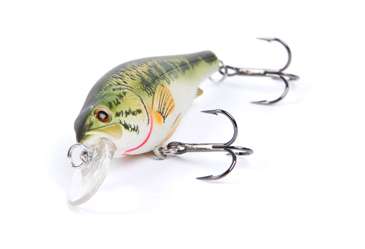
In part 1 of this three-part series, we looked at the bass' sense of smell. After talking to a biologist and an angler, we've determined that scent is not a sense bass rely heavily on to find prey. Scent becomes a factor after a fish is determining whether or not to swallow what it has just caught. Finding and tracking down prey is left to the fish's other senses, namely sight and vibration/sound.
Gene Gilliland, Central Region Supervisor for the Oklahoma Department of Wildlife Conservation, has studied bass for decades and fished for them even longer. He says that sight is the most important thing when getting a bass' attention.
"Bass are primarily sight feeders, but, like smell, the conditions a fish resides in determine what senses it's going to rely on most," he says. "For example, if a fish is in muddy water, the lateral line is more important. In clearer water, sight is going to be No. 1."
Sight is the bass' most relied-upon sense, but perfectly matching the forage's color and size doesn't always guarantee bites. Think of baits like Rat-L-Traps. A bass only gets a split second to examine the thing as it zips by. He can't afford to miss a meal that shoots right past his face, so quite often he'll snap at it.
"With bass, it's eat first, ask questions later," Gilliland says. "They don't always take the time to examine what they're about to eat, unless it's a slow-moving bait or they're in clear water."
Since sight is the bass' most relied upon sense, you need to appeal to it properly if you want the chance to get bit. In those clear-water and slow-moving situations, you need all the help you can get. In the first part of the series we found that a scented bait may have a better chance of making a bass
commit to eating. As far as sight goes, logic tells us that baits that look and move like real forage stand a better chance of getting bit than cruder ones.
Hey, good lookin' …
Tom Chopin, of Koppers Live Target Lures, believes as water gets clearer and more pressured, lifelike lures have a leg up over traditional hard baits. Koppers lures are made using a 3-D template that replicates baitfish as closely as possible. Chopin says that a quality paint job is 30 percent of a bait's appeal. The rest is performance.
"If you look at baitfish, they all have a different profile. Their bodies aren't shaped the same. So why would you paint baby bass and bluegill on the same fuselage?" he asks. "What we've been doing is matching the hatch like fly fishermen have been doing for years. Our 3-D bodies have multiple flash points that replicate the scales and facial definition of the baitfish as they move through the water."
Chopin uses the analogy of a cardboard cutout. If your buddy is standing next to a cardboard cutout of himself, you'd recognize the cutout, but it wouldn't look as realistic as him standing there. The cutout would also have a hard time moving like the real person. Koppers has integrated this theory into their lineup in an attempt to make the most realistic looking and moving baits on the market.
Elite Series pro Stephen Browning feels that highly detailed baits excel in clear water.
"In clear water, the bass is actually seeing the bait before the strike," he says. "I think the way Koppers pays attention to every detail about the baitfish — from the paint to the body shape to the way it swims — really gives me the upper hand when fish are feeding heavily on sight."
Browning likes the Crawfish Crank series by Koppers best.
"It's in the way it swims and deflects off things as well as the eyes. The little details make all the difference," he says. "There's not much to say 'no' to about them."




